#Scots-Irish Music
Video
youtube
Lecture 1: Early Hillbilly musician Al Hopkins (1889-1932) (along with his band, His Buckle Busters) performs “West Virginia Gals” from 1927. Music historians credit North Carolina-born Hopkins (1889-1932) with inventing the term “Hillbilly Music,” a type of music that combined folk (especially from the Appalachian Mountain region), bluegrass, gospel, Old-Time, Scots-Irish, and other types of traditional 19th Century American musical influences. Hopkins recorded his first songs in 1924 and quickly rose to stardom as one of the most famous early Hillbilly acts, but tragically his career was cut short by an auto accident in Virginia in 1932.
#Hillbilly Music#Country Music#Al Hopkins#Al Hopkins & His Buckle Busters#Bluegrass#Appalachian Mountain region#gospel#Old-Time Music#Scots-Irish Music#West Virginia Gals (1927)#1920s
0 notes
Photo

@petermorwood - by virtue of being able to say Irskt Þjó∂lög I have been nominated to introduce this piece when we play it.
How do I say the other things?
#imma bat a dragon#I'm actually guessing the first one is more like 'an drawn don'#not sure whether Irish is spoken with phlegm or not#replies#we can take the 'oh it's pronounced brown thorn bush' as given#it's a baffling piece of music#this is the 1. fí∂la part#but the directions are in English#and the title is... as you see#edit: now I'm staring at it going#'this is Scots isn't it? I've embarrassed myself haven't I? Scots is spoken with phlegm and the gh could be phlegm there'#but I don't know any Scots speakers
54 notes
·
View notes
Text
the appalachian murder ballad <3 one of the most interesting elements of americana and american folk, imo!
my wife recently gave me A Look when i had one playing in the car and she was like, "why do all of these old folk songs talk about killing people lmao" and i realized i wanted to Talk About It at length.
nerd shit under the cut, and it's long. y'all been warned
so, as y'all probably know, a lot of appalachian folk music grew its roots in scottish folk (and then was heavily influenced by Black folks once it arrived here, but that's a post for another time).
they existed, as most folk music does, to deliver a narrative--to pass on a story orally, especially in communities where literacy was not widespread. their whole purpose was to get the news out there about current events, and everyone loves a good murder mystery!
as an aside, i saw someone liken the murder ballad to a ye olde true crime podcast and tbh, yeah lol.
the "original" murder ballads started back across the pond as news stories printed on broadsheets and penned in such a way that it was easy to put to melody.
they were meant to be passed on and keep the people informed about the goings-on in town. i imagine that because these songs were left up to their original orators to get them going, this would be why we have sooo many variations of old folk songs.
naturally then, almost always, they were based on real events, either sung from an outside perspective, from the killer's perspective and in some cases, from the victim's. of course, like most things from days of yore, they reek of social dogshit. the particular flavor of dogshit of the OG murder ballad was misogyny.
so, the murder ballad came over when the english and scots-irish settlers did. in fact, a lot of the current murder ballads are still telling stories from centuries ago, and, as is the way of folk, getting rewritten and given new names and melodies and evolving into the modern recordings we hear today.
305 such scottish and english ballads were noted and collected into what is famously known as the Child Ballads collected by a professor named francis james child in the 19th century. they have been reshaped and covered and recorded a million and one times, as is the folk way.
while newer ones continued to largely fit the formula of retelling real events and murder trials (such as one of my favorite ones, little sadie, about a murderer getting chased through the carolinas to have justice handed down), they also evolved into sometimes fictional, (often unfortunately misogynistic) cautionary tales.
perhaps the most famous examples of these are omie wise and pretty polly where the woman's death almost feels justified as if it's her fault (big shocker).
but i digress. in this way, the evolution of the murder ballad came to serve a similar purpose as the spooky legends of appalachia did/do now.
(why do we have those urban legends and oral traditions warning yall out of the woods? to keep babies from gettin lost n dying in them. i know it's a fun tiktok trend rn to tell tale of spooky scary woods like there's really more haints out here than there are anywhere else, but that's a rant for another time too ain't it)
so, the aforementioned little sadie (also known as "bad lee brown" in some cases) was first recorded in the 1920s. i'm also plugging my favorite female-vocaist cover of it there because it's superior when a woman does it, sorry.
it is a pretty straightforward murder ballad in its content--in the original version, the guy kills a woman, a stranger or his girlfriend sometimes depending on who is covering it.
but instead of it being a cautionary 'be careful and don't get pregnant or it's your fault' tale like omie wise and pretty polly, the guy doesn't get away with it, and he's not portrayed as sympathetic like the murderer is in so many ballads.
a few decades after, women started saying fuck you and writing their own murder ballads.
in the 40s, the femme fatale trope was in full swing with women flipping the script and killing their male lovers for slights against them instead.
men began to enter the "find out" phase in these songs and paid up for being abusive partners. women regained their agency and humanity by actually giving themselves an active voice instead of just being essentially 'fridged in the ballads of old.
her majesty dolly parton even covered plenty of old ballads herself but then went on to write the bridge, telling the pregnant-woman-in-the-murder-ballad's side of things for once. love her.
as a listener, i realized that i personally prefer these modern covers of appalachian murder ballads sung by women-led acts like dolly and gillian welch and even the super-recent crooked still especially, because there is a sense of reclamation, subverting its roots by giving it a woman's voice instead.
meaning that, like a lot else from the problematic past, the appalachian murder ballad is something to be enjoyed with critical ears. violence against women is an evergreen issue, of course, and you're going to encounter a lot of that in this branch of historical music.
but with folk songs, and especially the murder ballad, being such a foundational element of appalachian history and culture and fitting squarely into the appalachian gothic, i still find them important and so, so interesting
i do feel it's worth mentioning that there are "tamer" ones. with traditional and modern murder ballads alike, some of them are just for "fun," like a murder mystery novel is enjoyable to read; not all have a message or retell a historical trial.
(for instance, i'd even argue ultra-modern, popular americana songs like hell's comin' with me is a contemporary americana murder ballad--being sung by a male vocalist and having evolved from being at the expense of a woman to instead being directed at a harmful and corrupt church. that kind of thing)
in short: it continues to evolve, and i continue to eat that shit up.
anyway, to leave off, lemme share with yall my personal favorite murder ballad which fits squarely into murder mystery/horror novel territory imo.
it's the 10th child ballad and was originally known as "the twa sisters." it's been covered to hell n back and named and renamed.
but! if you listen to any flavor of americana, chances are high you already know it; popular names are "the dreadful wind and rain" and sometimes just "wind and rain."
in it, a jealous older sister pushes her other sister into a river (or stream, or sea, depending on who's covering it) over a dumbass man. the little sister's body floats away and a fiddle maker come upon her and took parts of her body to make a fiddle of his own. the only song the new fiddle plays is the tale about how it came to be, and it is the same song you have been listening to until then.
how's that for genuinely spooky-scary appalachia, y'all?
#appalachia#appalachian murder ballads#murder ballads#appalachian music#appalachian culture#appalachian history#appalachian#appalachian folklore#appalachian gothic#tw violence against women#cw violence against women#cw murder#tw murder#folk music#folk#txt
436 notes
·
View notes
Text
Irish Shadows #658
Step out of the shadows and listen to the Irish & Celtic Music Podcast #658. Subscribe now!
Maggie’s Wake. Keltricity, Altan, Dancing With Hobbits, Tarren, Michael Darcy & The Atlantic Tramps, Telenn Tri, The BorderCollies, The Langer's Ball, Ironwood, Nick Metcalf, The Changing Room, Jimmy & Scots Folk Band, Karan Casey, Jigjam, Kinnfolk
GET CELTIC MUSIC NEWS IN YOUR INBOX
The Celtic Music Magazine is a quick and easy way to plug yourself into more great Celtic culture. Enjoy seven weekly news items for Celtic music and culture online. Subscribe now and get 34 Celtic MP3s for Free.
VOTE IN THE CELTIC TOP 20 FOR 2024
This is our way of finding the best songs and artists each year. You can vote for as many songs and tunes that inspire you in each episode. Your vote helps me create next year's Best Celtic music of 2024 episode. You have just three weeks to vote this year. Vote Now!
You can follow our playlist on Spotify to listen to those top voted tracks as they are added every 2 - 3 weeks. It also makes it easier for you to add these artists to your own playlists. You can also check out our Irish & Celtic Music Videos.
THIS WEEK IN CELTIC MUSIC
0:06 - Maggie’s Wake "Into The Shadows" from Maggie’s Wake
2:42 - WELCOME
4:15 - Keltricity "Sand Island - Maggie in the Rain - Steady On" from Live at Terra Firma Radio
7:57 - Altan "Liostáil mé le Sáirsint (Song)" from Donegal
11:03 - Dancing With Hobbits "Hobbit Polka" from Dancing With Hobbits
14:14 - Tarren "You to Me" from Revel
20:11 - FEEDBACK
23:00 - Michael Darcy & The Atlantic Tramps "Wild Rover No More" from Down to the Roots
25:52 - Telenn Tri "Weasel's Revenge set" from The Cat's Meow
31:25 - The BorderCollies "Twa Corbies" from To the Hills and Back
34:58 - The Langer's Ball "Air: Bygone Days" from Appetite for Tradition
36:58 - Ironwood "Selkie Song" from Gretna Green
40:10 - THANKS
41:54 - Nick Metcalf "Walls of Liscarrol / Christy Barry's Set" from Skyline of Skye
45:49 - The Changing Room "Delyow Sevi" from Picking Up The Pieces
47:52 - Jimmy & Scots Folk Band "HIGH KING'S REEL" from The Viking Irishman
50:02 - Karan Casey "By and By" from Nine Apples of Gold
54:30 - Jigjam "John D. McGurk's (The Heartbeat of St. Louis)" from Across The Pond
57:56 - CLOSING
58:45 - Kinnfolk "Loch Lomond" from The Knotted Circle
1:02:03 - CREDITS
The Irish & Celtic Music Podcast was produced by Marc Gunn, The Celtfather and our Patrons on Patreon. The show was edited by Mitchell Petersen with Graphics by Miranda Nelson Designs. Visit our website to follow the show. You’ll find links to all of the artists played in this episode.
Todd Wiley is the editor of the Celtic Music Magazine. Subscribe to get 34 Celtic MP3s for Free. Plus, you’ll get 7 weekly news items about what’s happening with Celtic music and culture online. Best of all, you will connect with your Celtic heritage.
Please tell one friend about this podcast. Word of mouth is the absolute best way to support any creative endeavor.
Finally, remember. Reduce, reuse, recycle, and think about how you can make a positive impact on your environment.
Promote Celtic culture through music at http://celticmusicpodcast.com/.
WELCOME THE IRISH & CELTIC MUSIC PODCAST
* Helping you celebrate Celtic culture through music. I am Marc Gunn.
This podcast is for fans of Celtic music. Not just the big names you’ve probably heard of. But also the Celtic bands in your neck of the woods, at your festivals.
It is here to build a diverse Celtic community and help the incredible artists who so generously share their music with you. If you hear music you love, please email artists to let them know you heard them on the Irish and Celtic Music Podcast. Musicians depend on your generosity to keep making music. So please find a way to support them. Buy a CD, Album Pin, Shirt, Digital Download, or join their communities on Patreon.
You can find a link to all of the artists in the shownotes, along with show times, when you visit our website at celticmusicpodcast.com.
Did you know that Patreon has an app?
It’s one of the easiest ways to listen to the podcast and also to vote in the Celtic Top 20.
If you are a Celtic musician or in a Celtic band, then please submit your band to be played on the podcast. You don’t have to send in music or an EPK. You will get a free eBook called Celtic Musicians Guide to Digital Music and learn how to follow the podcast. It’s 100% free. Just email Email follow@bestcelticmusic and of course, listeners can learn how to subscribe to the podcast and get a free music - only episode.
THANK YOU PATRONS OF THE PODCAST!
You are amazing. It is because of your generosity that you get to hear so much great Celtic music each and every week.
Your kindness pays for our engineer, graphic designer, Celtic Music Magazine editor, promotion of the podcast, and allows me to buy the music I play here. It also pays for my time creating the show each and every week.
As a patron, you get ad - free and music - only episodes before regular listeners, vote in the Celtic Top 20, stand - alone stories, you get a private feed to listen to the show or you can listen through the Patreon app. All that for as little as $1 per episode.
HERE IS YOUR THREE STEP PLAN TO SUPPORT THE PODCAST
Go to our Patreon page.
Decide how much you want to pledge every week, $1, $5, $25. Make sure to cap how much you want to spend per month.
Keep listening to the Irish & Celtic Music Podcast to celebrate Celtic culture through music.
You can become a generous Patron of the Podcast on Patreon at SongHenge.com.
TRAVEL WITH CELTIC INVASION VACATIONS
Every year, I take a small group of Celtic music fans on the relaxing adventure of a lifetime. We don't see everything. Instead, we stay in one area. We get to know the region through its culture, history, and legends. You can join us with an auditory and visual adventure through podcasts and videos. Learn more about the invasion at http://celticinvasion.com/
#celticmusic #irishmusic #celticmusicpodcast
I WANT YOUR FEEDBACK
What are you doing today while listening to the podcast? Please email me. I’d love to see a picture of what you're doing while listening or of a band that you saw recently.
Email me at follow@bestcelticmusic.
Mary Beth Carty emailed a photo: "Hi Marc,
Here is a pic of myself (accordion), my sister Lilly Cart (bodrhan), and my 3rd cousin Heather MacIsaac performing a concert of Irish songs and tunes at the Antigonish Heritage Museum, the former train station in my hometown. The acoustics are great in this space and there was a full crowd. Volunteers from the Heritage Association provided tea, juice, and snacks for the attendees. We did a number of sing - alongs and there were lots of moments when the crowd joined us on beautiful choruses. A great time! "
James OConnor emailed a photo: "Hi Marc Here is a pic with Jim O’Connor and Jim Chetz Keegan of Boston Blackthorne backstage at the beautiful Colony Theatre in Woodstock NY with the Dublin City Ramblers. We opened the show for the Ramblers who sounded fantastic and were incredibly gracious to us."
Jeffrey McCafferty emailed: "We had a record day in pittsburgh…America’s Grand St Patrick’s Day powered by the Pittsburgh Penguins…featuring 500,000 spectators, FNB’s St.Patrick’s Family Fair in the Square, 200 entries with 20,000 participants, great weather, 20 bands"
Virginia Davis emailed: "Hi Marc - Happy Birthday! I’m super - swamped today and maybe tomorrow, but I’ll get back to you as soon as possible! We actually have a new CD I need to get over to you - thanks! "
Betty Collette emailed a shirt picture: "Hi Marc - I was sewing pillows, cooking corned beef dinner, baking blueberry scones, and listening to Irish music. Here's my newest tshirt of The High Kings. We recently were lucky to see them nearby in Tomball, Texas!
Happy St. Patrick's Day and Happy Birthday, too!! "
Check out this episode!
3 notes
·
View notes
Text
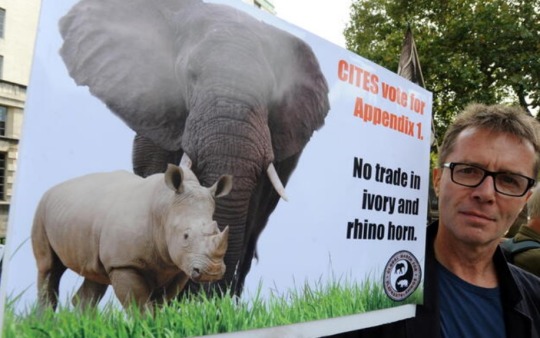


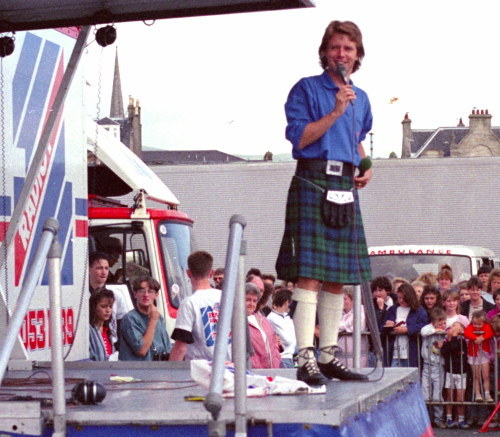
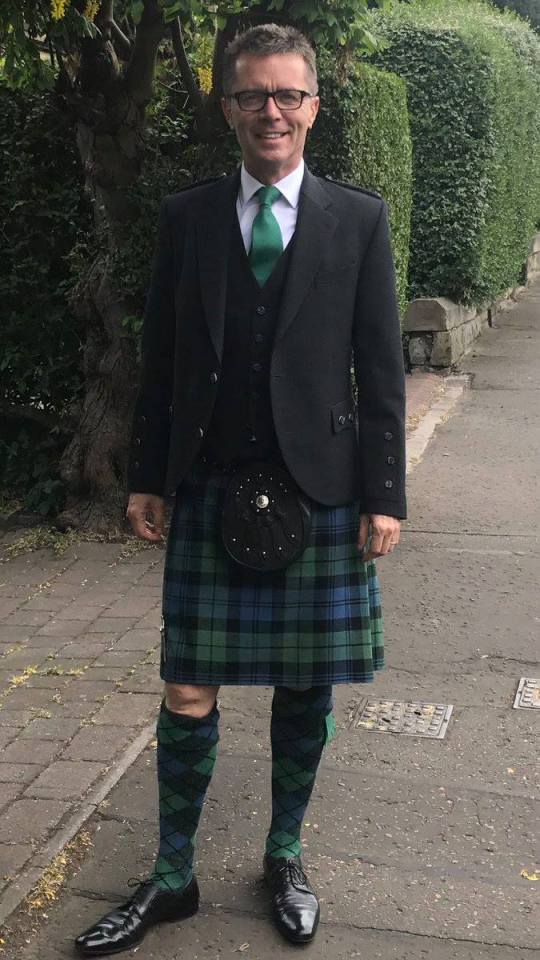
Happy Birthday Nicholas Andrew Argyll Campbell, better known as Nicky, born in Edinburgh, on April 10th 1961.
Best known for hosting Wheel of Fortune with fellow Scot Carol Smillie, but now the main show we might know him for is the very good Long Lost Family which aims to reunite close relatives after years of separation, often the people featured have been, like Nicky himself adopted, his "born" name was Nicholas Lackey he was adopted at four days old. His biological mother Stella was unmarried and had travelled from Ireland to give birth. Although she sent Christmas cards for the first five years of Nicky's life, they had no direct contact. It was not until he was in his 20's that Nicky decided to try and track down Stella and his biological father Joseph.
Although he discovered that his biological heritage was Irish, Nicky still thinks of himself as a Scot and it's his adoptive family, the Campbells, that he's closest to.
He was educated at the independent school Edinburgh Academy. His adoptive mother was a psychiatric social worker and his adoptive father a publisher of maps.
Nicky Campbell gained a history degree from Aberdeen University, and then became a jingle writer for Northsound Radio. At university, Campbell's best friend had been the actor Iain Glen.
Campbell went on to present the breakfast show there before crossing the border to join London's Capital Radio in 1986. Just a year later Nicky Campbell moved to Radio 1 where he had a variety of slots before moving to BBC Radio Five Live in October 1997. He regularly hosted Top of the Pops from 1988 to 1991 and again from 1994 to 1997.
He currently presents The Big Questions on BBC One and the aforementioned Long Lost Family, as well as his presenting he has written and co-produced a jazz swing album for singer and actor Mark Moraghan. As well as recording an album with the multi talented Kate Robbins. He is the director of a recording company who supply original music fro TV and films. On Radio Campbell has won seven Sony Awards, including a Gold Award in 2007 for the Radio 5 Live Breakfast programme as "Best News and Current Affairs Programme"
Nicky is a Patron of the British Association for Adoption and Fostering as well as he supports wildlife conservation and has works closely with Will Travers, Virginia McKenna and the Born Free Foundation.
In 2017 he made a documentary for the Women at War series for BBC1 with his adoptive mother Sheila Campbell.[18] He found out more about his her role in World War 2 and her experiences as a radar operator on D-Day.[Also that year he took part in All Star Musicals for ITV performing Razzle Dazzle from the musical Chicago live at the London Palladium.
In 2021 Campbell presented Manhunt; The Raul Moat Story on ITV1. This was the inside story of how Moat was tracked down, all in the glare of 24-hour rolling news. I n recent years Nicky has also been involved in a number of podcasts
Last year Police launch investigation after Campbell says he suffered abuse during his time at Edinburgh Academy in the 1970s. He made the claims during an episode of his BBC podcast Different, saying the experience had a "profound effect on my life".
The broadcaster said: "I was badly beaten up at school by a teacher who was a leading light in the scripture union.
"My mother took it as far as she could and got a grovelling apology from (the man involved), but was essentially stonewalled and it was hushed up by the school.
"Those were different times and that has stayed with me all my life."
The school said it "deeply" regrets the allegations and "wholeheartedly" apologised to those involved.
In a previously released statement, the school said: "We have worked closely with the relevant authorities including Police Scotland with their inquiries and would like to provide reassurance that things have dramatically changed since the 1970s.
"The Academy has robust measures in place to safeguard children at the school, with child protection training now core to the ethos of the Academy."
A New Radio 5 Live simulcast is due to start on Monday 17th April on the UK feed of BBC News and BBC Two. Nicky Campbell’s show will also be broadcast on BBC Two.
19 notes
·
View notes
Text
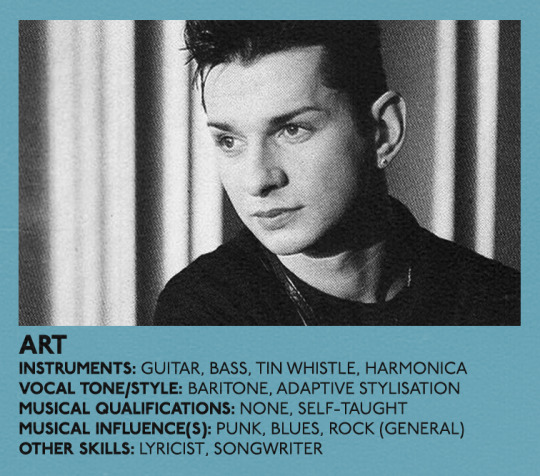
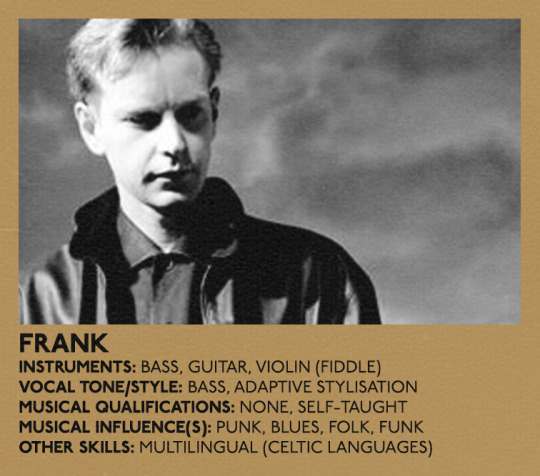

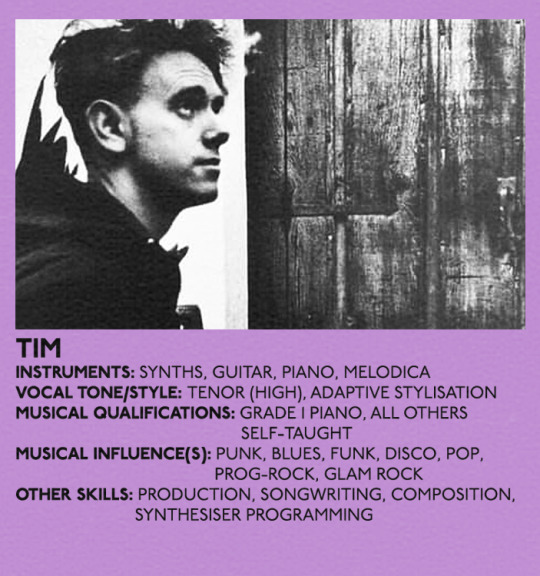
ODD FOXES + MUSICAL ABILITY
Here's a little breakdown of each of the Foxes' musical (including vocal + other skills) abilities and an idea of how they ended up with the sound they have.
ART
All of Art's instrumental ability is self-taught - he bought an acoustic guitar from a music shop when he was about ten (after saving his pocket money for weeks), and found a chord book at the library and taught himself. The tin whistle and harmonica came a little later when he was about thirteen, after acquiring both at a market in Basildon and teaching himself how to play them.
His vocals came naturally and is a touch lower than his baseline voice tone. He'd practised singing by learning his favourite songs and singing along.
Once he felt he was good enough at playing guitar and singing, he tried his hand at songwriting when he was fifteen with his strongest skill being his lyricism. Reg wanted him in Odd Foxes' original line-up because of his songwriting and vocal skill but was pleasantly surprised to learn that Art could also play guitar.
His main influences are: punk, blues, and general rock music - all of which he actively listens to on a near-daily basis.
FRANK
Like Art, all of Frank's instrumental ability is self-taught. Unlike Art, it was due to him having access to all three instruments at home and learning how to play folk songs (specifically Welsh folk songs). He started with the violin, which is rarely used on Foxes' songs but it is used, it's him playing it, then moved on to the guitar after becoming obsessed with Top Of The Pops and wanting to be a 'cool guitarist'... The bass became his main instrument because he preferred the sound of it and he was gifted one for his thirteenth birthday, so it was his most practised instrument of the three.
Frank learned how to sing early because of his family encouraging it and teaching him old Welsh folk songs, and the tone of his voice matches his normal speaking tone.
His only other skill is related to singing, which is his ability to sing in multiple Celtic languages (Welsh, Irish, Scots, etc.) - the others don't know the languages at all, while Frank grew up in a Welsh family and eventually learned other non-English Celtic songs as he grew up. His biggest proficiency (obviously) is in Welsh.
His main influences are: punk, blues, folk, and funk - all of which he actively listens to on a near-daily basis.
JAMES
Of all the Foxes, James has the most musical ability - not that people would really know that. He's been playing the drums from the age of six, having lessons through school, but he also had private piano and violin lessons - both of which, he's graded in (grade 3 piano and grade 2 violin). He learned the guitar, bass, flute, and harmonica for fun in his late teens.
Vocally, James is a tenor, which is just a touch higher than his normal speaking tone and this skill had been hidden from Foxes fans until after Frank's death and they released Polaroids as a single - on which, James sings the second verse.
His other skills all revolve around the studio-end of things: production, arrangement, and composition. He is self-taught in these skills, having learned them over time whilst making records.
His main influences are: punk, blues, prog-rock, folk, funk, thrash, and general metal - all of which he actively listens to on a near-daily basis.
TIM
In the original line-up, Tim was the most qualified musician, but since James joined, they're the second-most qualified. Synth keyboards are his favourite instrument to play, but his ability comes from a transferable skill in the form of his grade 1 piano - which they'd had private lessons for as a child until his parents couldn't afford the lessons anymore, but they kept at it. Guitar he picked up at Frank's and taught themself to play, while the melodica he had bought at a toy shop and purposely learned to play "properly" so that Foxes could use it in their music.
Tim's vocal ability was something he learned from growing up in a relatively musical family and being around Frank and his family from the age of about eleven - they're a higher tenor than James is and it's higher than his normal speaking tone. They are the highest vocal tone in the Odd Foxes line-up.
His songwriting skill they picked up whilst helping Art writing the original Odd Foxes songs early in the band's life, production and composition he learned similarly to how James did - on the job while making records. His synth programming skill, however, comes from Tim's obsessive special interest in synthesisers and learning exactly how they work and why - it's his most proficient skill in the studio.
His main influences are: punk, blues, funk, disco, pop, prog-rock, and glam rock l - all of which they actively listens to on a near-daily basis.
#ansicredocs#oddfoxesverse#artzzz#jamesfoxes#frankfoxes#artiefoxes#timfoxes#oddfoxeslore#oddfoxesart#artiefoxeslore#frankfoxeslore#jamesfoxeslore#timfoxeslore
3 notes
·
View notes
Text
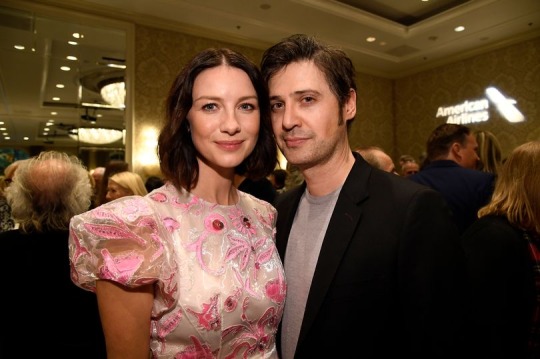
Getty
Note: Brian formatted all text in Italics
Outlander star Caitriona Balfe's husband's link with iconic Scottish band resurfaces
Tony McGill manages the Fratellis, the iconic Scottish band best known for their worldwide hit Chelsea Dagger, and is also good friends with broadcaster Gordon Smart.
Outlander star Caitriona Balfe's is so in love with Scotland due to her role in the smash-hit series that she is happily married to a Scotsman as well.
Tony McGill has been married to the Irish actress since August 2019 and recently welcomed a baby boy, whom the Claire Fraser actress was carrying while filming season six of Outlander.
But the Scots music producer's career has been kept under wraps due to the pair's very private life. He is known to be a musician and also owns a bar in London.
And another aspect of his social life was thrust to prominence late last week thanks to a radio interview involving Outlander star Lauren Lyle and broadcaster Gordon Smart.
He was covering for Irish comedian Patrick Kielty on his Saturday morning BBC Radio 5 Live show when they discussed the Scottish Six Degrees of Separation to link both the actress and Mr Smart.

Stazplay
It was discovered that the former Scottish Sun editor is actually very good friends with Mr McGill and mentioned that he manages iconic rock band The Fratellis.
The band is best known for their tune Chelsea Dagger which has been adopted by fans of the Scotland National Football Team and is often belted out at Hampden.
He was chatting to Ms Lyle about both Outlander and her new show, Karen Pirie, which is based on detective novels written by Val McDermid.
And the actress was describing how delighted she was that the drama had been given a second season by STV and that she was now being recognised in the street for two of her characters, with Marsali being the other one.
She said: "It's been received so well and even when the first episode came out I went into ITV and the receptionist went 'oh I love the show by the way' and it was suddenly such a weird thing that I was starting to get recognised for it straight away.
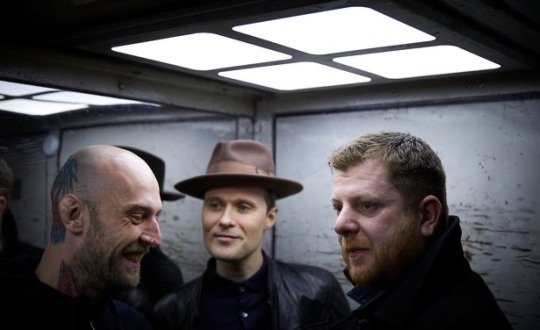
The Fratellis (PR pic as per Scottish Daily Express)
"I'm always recognised for Outlander, especially when I'm in Scotland. If American fans are over and they see Marsali walking down the streets of Edinburgh, they absolutely fall apart, are beside themselves.
"It must be amazing to have this show you are so passionate about and then see one of the characters, it's been really brilliant to get to do it again."
This prompted Mr Smart to put forward an "amazing bit of music trivia" as he labelled it a "ridiculous six degrees of separation." He said: "People might not know but Caitriona Balfe from Outlander is married to an amazing fella called Tony McGill who is a very good pal of mine.
"Now, Tony McGill — for anyone thinking why's he mentioning this, it's Scottish nonsense — Tony McGill manages a band you will know called the Fratellis. So that's what links Outlander to great music, Lauren Lyle to me today, and of course the much beloved Martin Compston who in Vigil for about 7 seconds."
Mr McGill and Ms Balfe first went public in 2015 on social media and were later photographed attending the 2016 ceremony for Jodie Foster's star on the Hollywood Walk of Fame.
Scottish Daily Express
The Italics: 1. He’s a manager, not a producer. 2. If Tony is a musician or currently owns a bar in London, it’s news to me. 3. Not sure what the writer means by “public in 2015 on social media.” Brian’s blog includes a video and three photos all posted on Instagram in 2014.
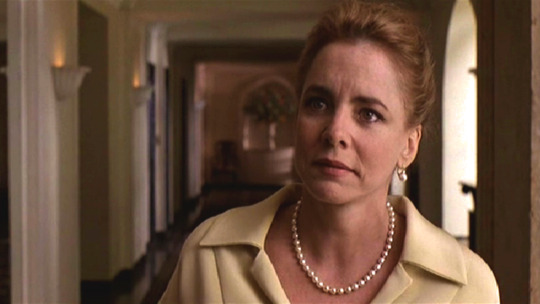
IMDb
Remember… I read somewhere that everybody on this planet is separated by only six other people. Six degrees of separation between us and everyone else on this planet. The President of the United States, a gondolier in Venice, just fill in the names. I find it extremely comforting that we're so close. I also find it like Chinese water torture, that we're so close because you have to find the right six people to make the right connection... I am bound, you are bound, to everyone on this planet by a trail of six people. — Ouisa Kittredge (character played by Stockard Channing in John Guare’s 1993 film Six Degrees of Separation)
#Tait rhymes with hat#Good times#Scottish Daily Express#7 March 2023#Six Degrees of Separation#BBC#Radio 5 Live#Patrick Kielty#Gordon Smart#Lauren Lyle#4 March 2023#Thanks caitrionabalfestanclub
37 notes
·
View notes
Photo
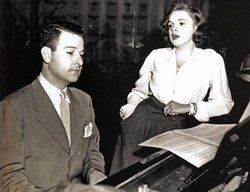
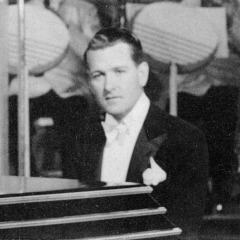
Roger Edens (deceased)
Gender: Male
Sexuality: Gay
DOB: 9 November 1905
RIP: 13 July 1970
Ethnicity: Scots-Irish
Nationality: American
Occupation: Composer, musician, producer
Note: Is considered one of the major creative figures in Arthur Freed’s musical film production unit at Metro-Goldwyn-Mayer during the “golden era of Hollywood”
#Roger Edens#lgbt history#lgbt#lgbtq#mlm#male#gay#1905#rip#historical#white#scottish#irish#composer#musician#producer#songwriter#old hollywood
72 notes
·
View notes
Note
Do you have any resources on traditional Celtic songs or sheet music? Throughout the British Isles? Thanks 💚
Hey, thanks for the question!
I don't know much about traditional Cornish, Welsh, and Breton music, perhaps one of my followers might be able to tell you more.
For Irish, Scottish, and Manx music I can recommend
The Session - lots of excellent (mostly irish, but some scottish and manx) session tunes
Tobar an Dualchais - Scottish Gaelic and Scots-language songs, poems, and stories with recordings and transcriptions
Traditional Tune Archive - A wikipedia style website with entries for TONS of traditional fiddle tunes
I'd also recommend heading over to RateYourMusic.com and looking at their genre list, it has lists of albums from almost every genre imaginable, including Celtic ones.
Hope this helps!
#celtic#celtic music#gaelic#gaelic music#irish#irish music#scottish music#scottish gaelic#manx#puirt a beul#sean-nos
4 notes
·
View notes
Photo


In expressing my opinion of the English I shall be frank. If I see much that is admirable, I see much also that is imperfect and not infrequently my sense of this imperfection has been heightened by the conviction of so many English people that nothing but perfection dwells within their shores....
I shall be doing no more than thinking aloud, and those I address are those who move around me, the English among whom I live, whose interests are mine, and whose prejudices, to some extent, I have adopted. Honest I shall be, in so far as I shall try honestly to express my bias.
I am speaking about the English, not about the British. There is no question in this work of the Scots, proud, intelligent, religious and unfathomable. Nor the Welsh, minute, musical, clever and tempermental. I am not writing about the charming untruthful, bloodthirsty and unreliable Irish. I shall be exclusively concerned with the English, the unintellectual, restricted, stubborn, steady, pragmatic, silent and reliable English.
- Gustaaf Johannes Renier, The English: Are They Human? (1931)
G. J. Renier (1892–1962) was born in Flushing, Netherlands, the child of a Dutch father and a French-speaking Belgian mother. He was sent to school in Antwerp and Leuven, and studied History at the University of Ghent, beginning a doctorate under Henri Pirenne. At the outbreak of the First World War he fled to England, and remained there working as a journalist, biographer and translator, before completing a doctorate under Pieter Geyl. In 1936 he succeeded Geyl as Reader in Dutch History at University College London, retiring in 1957.
32 notes
·
View notes
Text
Term's Hillbilly and Redneck
The term "hillbilly" in the United States started early in the 18th century when British soldiers began using it when referring to Scots-Irish immigrants who lived in the frontier areas of the Ozarks and Appalachian Mountains. These Protestant Irish colonists brought their traditions with them when they immigrated. Many of their stories, songs, and ballads dealt with the history of their Ulster and Lowland Scot homelands, especially relating the tale of the Protestant King William III, Prince of Orange. Many of the settlers in the Appalachian mountains were of German origin and were named Wilhelm with the short form Willy, a common German name during that time. Those Wilhelms, who went by Bill or Billy, living in the Appalachian Mountains became known as hillbillies, that is Bills who lived in the hills. The term emerged as a derogatory nickname given by the coastal plain-dwelling Southerners to the hill-dwelling settlers of Eastern Tennessee, Western Virginia (including modern West Virginia), and Eastern Kentucky.
The term Appalachian Hillbillies arose in the years after The War Between the States, when the Appalachian region became increasingly bypassed by technological and social changes taking place in the rest of the country. Until The War Between the States, the Appalachians were not significantly different from other rural areas of the country, but after the war, as the frontier pushed further west, the Appalachian country retained its frontier character, and the people themselves came to be considered as backward, quick to violence, and to make their living from moonshine stills. Fueled by news stories of mountain feuds, such as that in the 1880s between the Hatfields and McCoys, the hillbilly stereotype developed in the late nineteenth and early twentieth century.
The origins of the term "redneck" are Scottish and refer to supporters of the National Covenant and The Solemn League and Covenant, or Covenanters, largely Lowland Presbyterians, many of whom would flee Scotland for Ulster (Northern Ireland) during persecutions by the British Crown. The Covenanters of 1638 and 1641 signed the documents that stated that Scotland desired the Presbyterian form of church government and would not accept the Church of England as its official state church. Although the term "redneck" is characterized by farmers having a red neck caused by sunburn from hours working in the fields, many Covenanters signed in their own blood and wore red pieces of cloth around their necks as distinctive insignia. Since many Ulster-Scottish settlers in America (especially in the South) were Presbyterian, the term was applied to them, and then, later, their Southern descendants. One of the earliest examples of its use comes from 1830, when an author noted that red-neck was a name bestowed upon the Presbyterians.
The term Redneck refers to a stereotype of usually rural, Caucasian people of lower socio-economic status in the United States and Canada. Originally limited to the Appalachians, and later the South, the Ozarks, the Great Plains and the Rocky Mountains, this stereotype is now widespread throughout North America. Southern comedian Jeff Foxworthy defines "redneck" as "a glorious lack of sophistication" stating that we are all guilty of at one time or another. The common stereotype of a "redneck" is a group of people that are generally from The South, though can be found throughout the United States. They are considered uncivilized, uneducated, racist, enjoy outdoor sports such as hunting and fishing, and country music. They know how to work on a farm, can fix their own vehicles, and know how to make moonshine. They tend to live in the backwoods.
The terms "hillbilly/redneck" is often misunderstood by those north of the Mason-Dixon line. Many Yankees use these terms to refer to Southerners and treat them as if they were illiterate, uneducated, inbred, and backward compared to the rest of the United States. you know what you believe and you aren't afraid to say so, no matter who is listening; you respect your elders; or, you'd give your last dollar to a friend in need.
(Edited From Facebook)
2 notes
·
View notes
Note
I also just had a thought, from your O!Ciel|Fenian theory?
O!Ciel plays the violin.
I used to think that was just a reference to the demon associations, because it's a pretty common Thing. (There's the idea that Paganini sold his soul to play so well, and there's also that song "The Devil Went Down to Georgia", and there are probably more references I don't know.)
But.
The fiddle is a pretty important instrument in Celtic music, right? And from what I understand, that's just another name for the same instrument.
(part 2)
Hi, it's me again---I've realized that you might have already seen that connection between fiddles/violins and O!Ciel and I just haven't run into your post about it yet, in which case please feel free to ignore my earlier ask.
*
Under the cut because my reply is long.
There's a direct historical link between the Irish and Scottish immigrants in the early United States, and what would eventually evolve into Country Music.
"The Devil Went Down to Georgia" is a good example of this actually... parts of the violin solo, particularly the last 30 seconds of the violin solo at the end of this song, sounds almost exactly like what you'd expect of a random Irish folk solo.
Scottish and Irish immigrants also influenced American Square Dancing, it's a very bastardized grandchild of Irish step and other Scottish forms of dance.
I can't say that "Ireland/the scots/celts invented the violin" because almost every single country in the old world will swear up and down they "invented" what would become the thing. And that's part of why I didn't say anything sooner, it's easily dismissed as a coincidence and something that simply suited his character... But.
I do know that the oldest known bowed instrument in the world that was still somewhat intact, was found Dublin and they were said to be as old as the 11th century. Though there are references that suggest people played them even earlier than that.
So obviously, the violin is the eventual predecessor of these early instruments and you're right, it's a staple of Celtic music.
As much of a scandal as it is to say, we know that stringed + bowed instruments were even older than pipes/bag pipes.
There's records of these similar instruments that were bowed and plucked referred to as 'fiddles,' as well.
To be honest, the only reason I haven't made mention of it is simply, because there's people who will swear up-and-down that there's a big difference! Between Classical Violin, and "The Celtic Fiddle", and Our!Ciel is more-than-likely learning Classical Violin pieces.
It's worth mentioning that a lot of this "Big differences!" people are talking about ... have nothing to do with the instrument itself. The instrument is literally identical. It's just the techniques, song choices, and style that the instrument is played in that they mean... that's it.
I can't tell you how many people I've met that sincerely thought that "country fiddles" and "irish fiddles" were literally somehow, entirely different instruments-- that an "irish fiddle" was cheap garbage compared to a "WELL MADE!" overpriced-as-shit violin.
Anti-irish sentiments at it's best, what can I say.
In terms of stringed instruments with a possible Irish connection, a harp, might have been another option when coming up with his character design and what-not... But unfortunately... harps by then... were so heavily associated with other things as well in Christianity.
I don't see it being O!Ciel's first choice (I don't think he'd want to play the harp... it's too "angelic").
Violins are also known, for sounding much more emotional, have that 'haunted' quality, and have a reputation for sounding sad ("Let me play you a song on the world's smallest violin..." from spongebob, comes to mind whenever I think of the violin) and I think it just seemed like the perfect choice, for his character in a general sense.
Although!
The conscious choice to play it... in the context of his heritage, while playing the part of A Queen-loving Noble Aristocrat ... is a lot like him, in a way. Hiding in plain sight, hiding in the ambiguity. A subtle nod to his heritage that's too subtle for anyone else to notice, or "call him out" for- because Violins are very multi-cultural as well. Integrated. Respected. An instrument, that's just acceptable enough as long as you play it the right way.
So what I do think?
While it may have been a coincidence, simply because it's such a popular and emotional instrument that is loved across cultures that sincerely suited his character best, however, it's also equally possible that it wasn't a coincidence at all.
That these thoughts were considered, by Yana when deciding what instrument Sebastian was going to teach to him.
#O!Ciel#Our!Ciel#Tagging Finnian name theory because I do not want to lose it#Finnian name theory#Fenian name theory
14 notes
·
View notes
Text
Summarizing TV shows I've never seen
Breaking Bad: takes place where high school musical did. Jesse and Walter. 99% sure Walter's the bald chem teacher. Jesse is either gay, homophobic, or both (?). There's a lawyer woman named Skylar who Walt may or may not be hitting on the side, not sure. Meth.
Yugioh: kid has cards that can summon magical creatures. I think there's a hell realm. There's one guy, Marik, who is actually two guys in one I think, but I wouldn't swear by it.
My Hero Academia: something to do with toe joints????? Is that like. correct???? I distinctly remember something about that. There's the frog guy, bakugou (the zuko one), Deku (not the zelda tree), and the girl that looks like May from pokemon or Suki from ATLA.
Fairy Tail: I actually have seen this one but couldn't tell you a damn thing about it. There's a guild thing. Lots of fanservice. Guy with the scarf.
Miraculous Ladybug: guy and girl are in love but also superheroes who are in love and nobody knows the oter is in love and a superhero? Shenanigans ensue. They're a ladybug and a cat but in a superhero way and not a furry way.
Fox 911: copaganda but firefighters????? no idea. Swifties really like it.
Friends: I've seen SOME episodes. Two of the guys look like the same guy to me and I can't tell them apart. Friends say I'm the phoebe because she's kind of got a hippie vibe. Rachel and Monica are not wlw apparently but you could have fooled me. SMELLY CAT. Also what's his name... david schwimmer. His character is kind of annoying to me. He had a monkey once? Also CLAP CLAP CLAP CLAP!!!!
Supernatural: dude. NO fucking idea. Superhell. The two guys might be gay? or brothers? There's a third guy I think???? Someone's gay and someone's got a brother? They had a scooby doo crossover. Demons.
Doctor who: time travel in a phone booth??? There's a bunch of doctors. fifteen of them? One said feminist rights or something???
Supernatural: Sadie Sink, who people said I looked like in my red hair era. I think we're both just scots-irish 20somethings though idk. 80's. Byler. A lot of bowl cuts, unfortunately.
Amphibia: frogs and a blonde girl???
Moral Orel: No idea but it kind of scares me /lh. @blossyossyossy likes it.
Modern Family: family issues but there's a bazillion of them. My mom says I look like Haley dunphy. Idk who that is. Funny enough, Haley dunphy and Sadie sink look nothing alike yet I've been told I look like both of them. I don't see either, tbh.
#taylor's tag#breaking bad#yugioh#my hero academia#ok i'm not tagging all of these#out of laziness and out of not tag spamming even though it's relevant
18 notes
·
View notes
Text

Selkies are mythological creatures that can shapeshift between seal and human forms by removing or putting on their seal skin. They feature prominently in the oral traditions and mythology of various cultures, especially those of Celtic and Norse origin. The term “selkie” derives from the Scots word for “seal”, and is also spelled as silkies, sylkies, or selchies. Selkies are sometimes referred to as selkie folk (Scots: selkie fowk), meaning 'seal folk'. Selkies are mainly associated with the Northern Isles of Scotland, where they are said to live as seals in the sea but shed their skin to become human on land.
Selkies have a dual nature: they can be friendly and helpful to humans, but they can also be dangerous and vengeful. Selkies are often depicted as attractive and seductive in human form, and many stories involve selkies having romantic or sexual relationships with humans, sometimes resulting in children. Selkies can also be coerced or tricked into marrying humans, usually by someone who steals and hides their seal skin, preventing them from returning to the sea. Such marriages are often unhappy, as the selkie always longs for the sea and may eventually escape if they find their skin.
Selkies have counterparts in other cultures, such as the Faroese, Icelandic, Irish, and Manx. They are sometimes confused with other seal-like creatures, such as the mermaids or the finfolk. Selkies have inspired many works of art, literature, music, and film.
#selkie#mythology#classical mythology#mythical creatures#mythos#myth#sea monster#legendary creature#monster#mythical art#mythical oc#norse#norse mythology#nordic#celtic mythology#irish mythology#scottish#scottish mythology
5 notes
·
View notes
Text
X-Men and Cultural Appropriation
I pretty much pointed out how the X-Men writers have indulged in cultural appropriation to varying degrees, in the sense that the mutants are stand-ins for ethnic minorities but most of them don’t speak minority languages. Mind you, minority languages are minority because they’re not commonly spoken due to being stigmatised and discouraged. People would get whacked if they spoke in such a language, whilst this never really happened in the X-Men stories as far as I remember. It doesn’t help when at least most X-Men writers either don’t speak any minority language or bother learning it, which would explain the ironically appropriative air X-Men stories give off.
Like they co-opt minority experiences but almost none of the writers are either into minority cultures nor are they minorities themselves, this is likely why both Sean and Theresa Cassidy fit Irish stereotypes but neither of them speak Irish. It wouldn’t hurt if Rahne Sinclair actually spoke Scots instead of weird butchered English she sometimes she’s slotted into, I don’t think there are any mutants who speak Venetian, Lombard/Milanese, Low German and Saterland Frisian either. Again this involves a greater admiration for something this marginalised as a minority language of any given country than is commonly shown and done in X-Men comics, honestly I got into Irish because of loving Irish foik music.
So there is a difference between cultural appreciation and cultural appropriation, the former involves actually loving and respecting the culture in question and the other makes a mockery out of it when borrowed though sometimes they are blurred together. (Trust me, it’s like that with me when it comes to China until recently.) The X-Men stories and their respective writers frequently fall into the latter, especially when it comes to non-American and/or nonwhite mutants. This is likely why as I said before, both Cassidys are Irish stereotypes who neither speak Irish to any degree.
It’s kind of tragic when you realise how there is a difference between reiterating ethnic stereotypes and having any real appreciation for/interest in certain cultures, this may not always be the case but it seems in my case my interest in Ireland stemmed from learning Irish from Irish folk music. I don’t think X-Men stories ever lead me to loving foreign cultures the way I did with Irish folk music, so it becomes really evident that X-Men writers have co-opted the experiences of minorities for their characters and stories but show no real interest in those people themselves.
It’s not just that Siryn and her father are Irish stereotypes (or at least started out as such), but how the other mutants don’t speak any minority language which would’ve furthered the minority comparison more. There aren’t any mutants who speak Lombard, Venetian, Breton, Welsh, Frisian, Low German, Sicilian, Sardinian, Scots, Scottish Gaelic, Kurdish and Nahuatl, maybe until recently, despite X-Men writers’ tendency to harp on mutants as the ultimate minority, the minority of all minorities within Marvel stories. You might say that they’re obscure and irrelevant, but they are important markers of social identity to some people.
If I were to compare X-Men to any one of the Milestone stories (Icon and Blood Syndicate), the latter two are written by members of actual minorities so there’s going to be an authenticity that most X-Men stories lack. If X-Men writers and stories alike reveal an insincerity in showing the (ethnic) minority perspective, this could partly explain why not a lot of mutants speak minority languages. This may not always be the case, but it is telling how this aspect of social identity gets missed out. If X-Men stories are inadequate and untrustworthy when it comes to the minority language, perhaps something else does.
One that even outdoes X-Men when it comes to portraying ethnic/linguistic minorities at all, especially when written by actual minorities and/or those who speak minority languages.
#irish language#ireland#x-men#marvel#marvel comics#minority language#minority languages#cultural appropriation#siryn#theresa cassidy#sean cassidy#milestone comics#scots#scots language#rahne sinclair
3 notes
·
View notes
Text
Audio 🎧 🔊 ON from BBC Sounds

Twitter
I cannot believe it has come to this. Nowhere on earth or in any near galaxy did mushka-mushk say Tony writes, performs, or produces Outlander’s music.* 🤦🏻♂️ She quoted Gordon Smart. Note the “ before Caitriona and after today ”
*Nor does he sing backup on Sinéad O’Connor’s Season 7 Skye Boat Song. Brian’s wee joke…
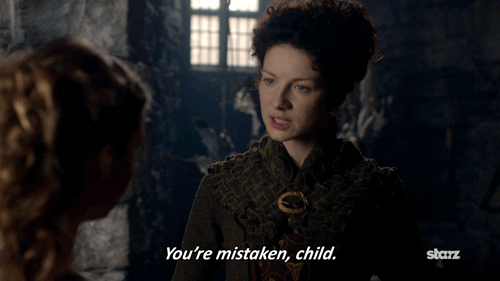
Gordon hosted Patrick Kielty’s show and interviewed Lauren. This is Patrick:

BBC Sounds
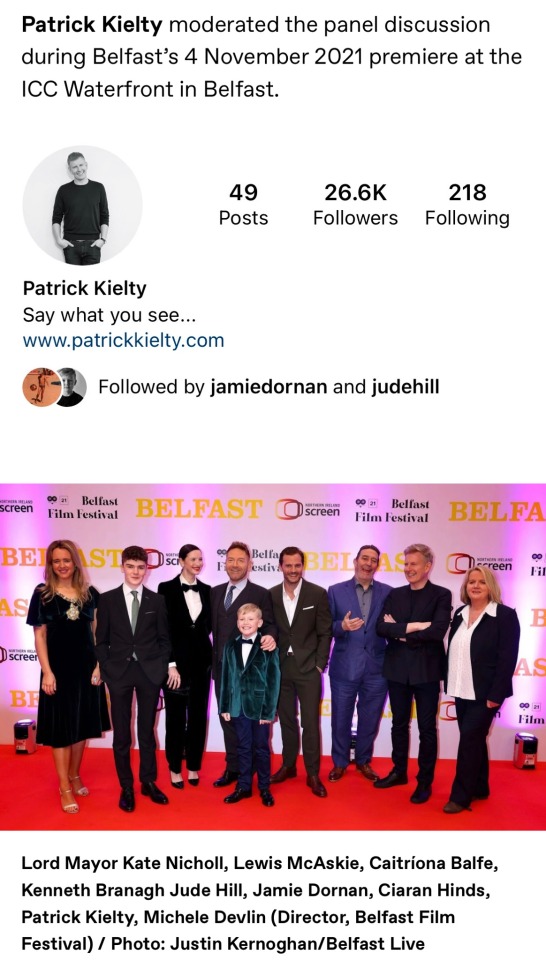
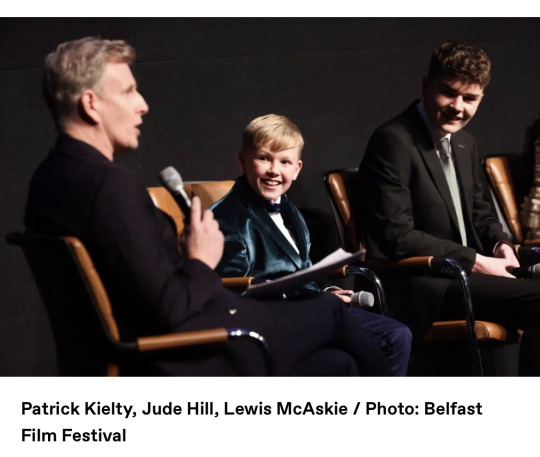
He and and fellow Northern Irishman Jamie Dornan are good mates.
Brian’s 17 April 2022 post
This is Gordon:
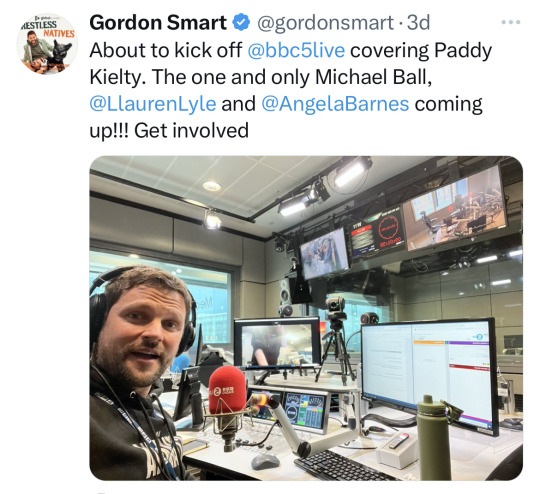
Twitter

Note how he resembles the man pictured in the video screenshot at the top of the screen? 🤯 Unlike Patrick, Gordon is a Scot… and listening to any 10 seconds of Gordon’s talking to Lauren assures you he’s not Irish. You might even pick up he’s from Kinross. Reminds me of people’s somehow thinking Glaswegian Tony is Irish…

Brian’s 12 April 2021 post
But i digress… 😬… my point is, saying mushka_mushk is friends with Tony who writes Outlander’s music — and all the other misinformation that’s circulating about Lauren’s interview (screenshot ⬇️) — could have avoided by simply listening to the interview before reacting.
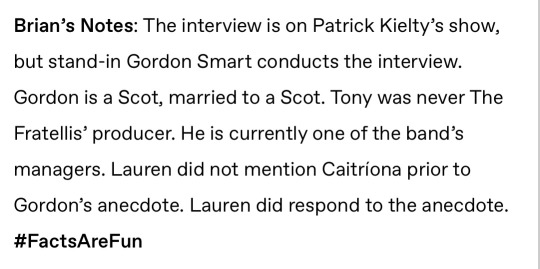
Brian’s 6 March 2023 post
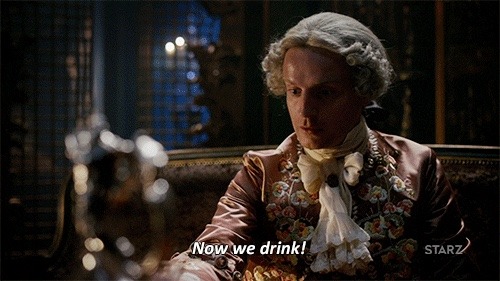
Remember… you can't fake listening. It shows. — Raquel Welch
#Tait rhymes with hat#Good times#BBC#Radio 5 Live#BBC Sounds#Lauren Lyle#Patrick Kielty#Host#Gordon Smart#4 March 2023#Audio#My screenrecording#Twitter
15 notes
·
View notes